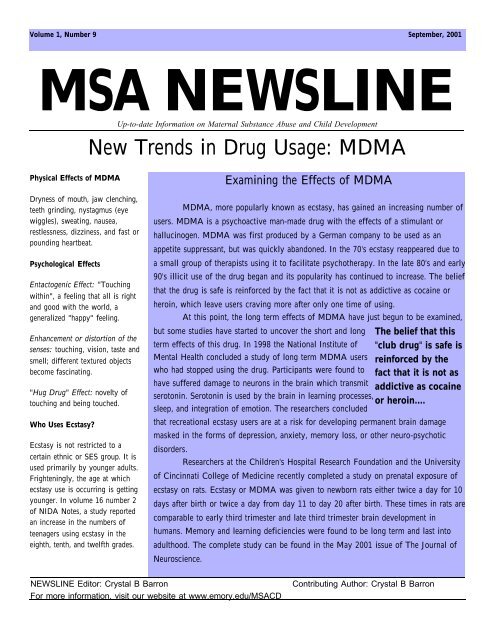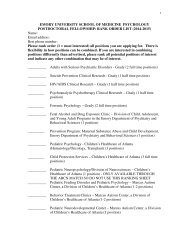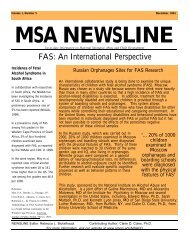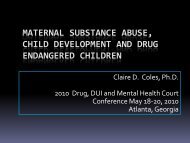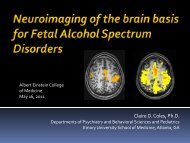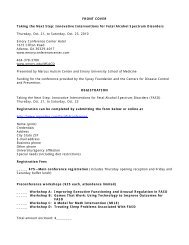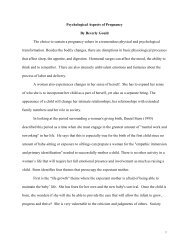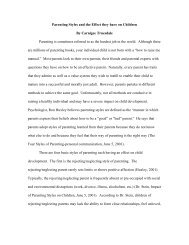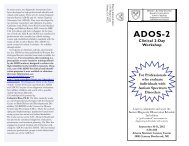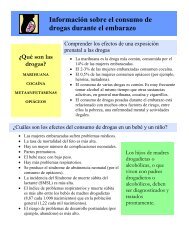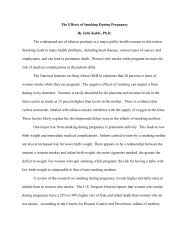MDMA and Ecstasy - Emory Psychiatry - Emory University
MDMA and Ecstasy - Emory Psychiatry - Emory University
MDMA and Ecstasy - Emory Psychiatry - Emory University
Create successful ePaper yourself
Turn your PDF publications into a flip-book with our unique Google optimized e-Paper software.
Volume 1, Number 9 September, 2001<br />
MSA NEWSLINE<br />
Up-to-date Information on Maternal Substance Abuse <strong>and</strong> Child Development<br />
New Trends in Drug Usage: <strong>MDMA</strong><br />
Physical Effects of <strong>MDMA</strong><br />
Dryness of mouth, jaw clenching,<br />
teeth grinding, nystagmus (eye<br />
wiggles), sweating, nausea,<br />
restlessness, dizziness, <strong>and</strong> fast or<br />
pounding heartbeat.<br />
Psychological Effects<br />
Entactogenic Effect: "Touching<br />
within", a feeling that all is right<br />
<strong>and</strong> good with the world, a<br />
generalized "happy" feeling.<br />
Enhancement or distortion of the<br />
senses: touching, vision, taste <strong>and</strong><br />
smell; different textured objects<br />
become fascinating.<br />
"Hug Drug" Effect: novelty of<br />
touching <strong>and</strong> being touched.<br />
Who Uses <strong>Ecstasy</strong>?<br />
<strong>Ecstasy</strong> is not restricted to a<br />
certain ethnic or SES group. It is<br />
used primarily by younger adults.<br />
Frighteningly, the age at which<br />
ecstasy use is occurring is getting<br />
younger. In volume 16 number 2<br />
of NIDA Notes, a study reported<br />
an increase in the numbers of<br />
teenagers using ecstasy in the<br />
eighth, tenth, <strong>and</strong> twelfth grades.<br />
Examining the Effects of <strong>MDMA</strong><br />
<strong>MDMA</strong>, more popularly known as ecstasy, has gained an increasing number of<br />
users. <strong>MDMA</strong> is a psychoactive man-made drug with the effects of a stimulant or<br />
hallucinogen. <strong>MDMA</strong> was first produced by a German company to be used as an<br />
appetite suppressant, but was quickly ab<strong>and</strong>oned. In the 70's ecstasy reappeared due to<br />
a small group of therapists using it to facilitate psychotherapy. In the late 80's <strong>and</strong> early<br />
90's illicit use of the drug began <strong>and</strong> its popularity has continued to increase. The belief<br />
that the drug is safe is reinforced by the fact that it is not as addictive as cocaine or<br />
heroin, which leave users craving more after only one time of using.<br />
At this point, the long term effects of <strong>MDMA</strong> have just begun to be examined,<br />
but some studies have started to uncover the short <strong>and</strong> long The belief that this<br />
term effects of this drug. In 1998 the National Institute of "club drug" is safe is<br />
Mental Health concluded a study of long term <strong>MDMA</strong> users reinforced by the<br />
who had stopped using the drug. Participants were found to fact that it is not as<br />
have suffered damage to neurons in the brain which transmit addictive as cocaine<br />
serotonin. Serotonin is used by the brain in learning processes,<br />
or heroin....<br />
sleep, <strong>and</strong> integration of emotion. The researchers concluded<br />
that recreational ecstasy users are at a risk for developing permanent brain damage<br />
masked in the forms of depression, anxiety, memory loss, or other neuro-psychotic<br />
disorders.<br />
Researchers at the Children's Hospital Research Foundation <strong>and</strong> the <strong>University</strong><br />
of Cincinnati College of Medicine recently completed a study on prenatal exposure of<br />
ecstasy on rats. <strong>Ecstasy</strong> or <strong>MDMA</strong> was given to newborn rats either twice a day for 10<br />
days after birth or twice a day from day 11 to day 20 after birth. These times in rats are<br />
comparable to early third trimester <strong>and</strong> late third trimester brain development in<br />
humans. Memory <strong>and</strong> learning deficiencies were found to be long term <strong>and</strong> last into<br />
adulthood. The complete study can be found in the May 2001 issue of The Journal of<br />
Neuroscience.<br />
NEWSLINE Editor: Crystal B Barron<br />
For more information, visit our website at www.emory.edu/MSACD<br />
Contributing Author: Crystal B Barron
Volume 1, Number 9 September, 2001<br />
If this is your brain on ecstasy,<br />
imagine its effects on a<br />
developing fetus....<br />
This picture shows two images<br />
of a brain; the image on the left<br />
is of an individual who has never<br />
used drugs, <strong>and</strong> the image on the<br />
right is an an ecstasy user who<br />
has abstained from use for three<br />
weeks prior to the brain scan.<br />
The bright reddish areas are<br />
serotonin sites in the brain which<br />
regulate mood, emotion,<br />
<strong>Ecstasy</strong> users are mainly young men <strong>and</strong> women, in the<br />
prime of their childbearing years. The psychological effects<br />
of ecstasy have been described as ego softening, a<br />
dissolving of all fears, <strong>and</strong> feelings of emotionally based<br />
love <strong>and</strong> empathy. The combination of the age of the users<br />
<strong>and</strong> the above mentioned effects often have negative<br />
consequences: they can result in unprotected sex <strong>and</strong><br />
unwanted pregnancies. Prevention campaigns should be<br />
increased to alert people to the risks of ecstasy use, <strong>and</strong> to<br />
forewarn users of the risks of prenatal exposure to ecstasy.<br />
For more information regarding this subject or other<br />
related topics, please contact Crystal Barron, Maternal<br />
Substance Abuse <strong>and</strong> Child Development Project, <strong>Emory</strong><br />
<strong>University</strong> School of Medicine, Department of <strong>Psychiatry</strong> <strong>and</strong><br />
Behavioral Sciences, <strong>Emory</strong> West Campus, 1256 Briarcliff<br />
Road, N.E., Suite 324W, Atlanta, GA., 30306. You can also<br />
phone us at 404-712-9829 or check our website at<br />
www.emory.edu/MSACD<br />
learning, memory, <strong>and</strong> sleep.<br />
The dark sections on the<br />
image on the left are<br />
serotonin sites that are no<br />
longer present due to ecstasy<br />
use. Although serotonin sites<br />
do re-grow, they do not<br />
grow back normally <strong>and</strong><br />
they do not always grow<br />
back in the right locations.<br />
For more information on<br />
<strong>MDMA</strong>, visit these websites<br />
www.drugabuse.gov<br />
www.clubdrugs.org<br />
www.nida.nih.gov<br />
Maternal Substance Abuse <strong>and</strong><br />
Child Development Project<br />
1256 Briarcliff Rd., NE Suite 323W<br />
<strong>Emory</strong> West Campus<br />
Atlanta, GA 30306<br />
The Maternal Substance Abuse <strong>and</strong> Child Development Project is dedicated to the study <strong>and</strong> prevention of the effects<br />
of maternal substance abuse. Since 1978, the project has studied the development of children exposed to alcohol <strong>and</strong><br />
other drugs prenatally <strong>and</strong> their caregivers <strong>and</strong> provided training for Prevention statewide. For additional information<br />
call (404) 712-9800.


